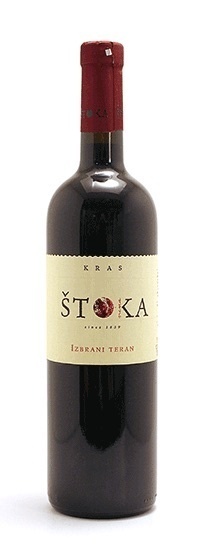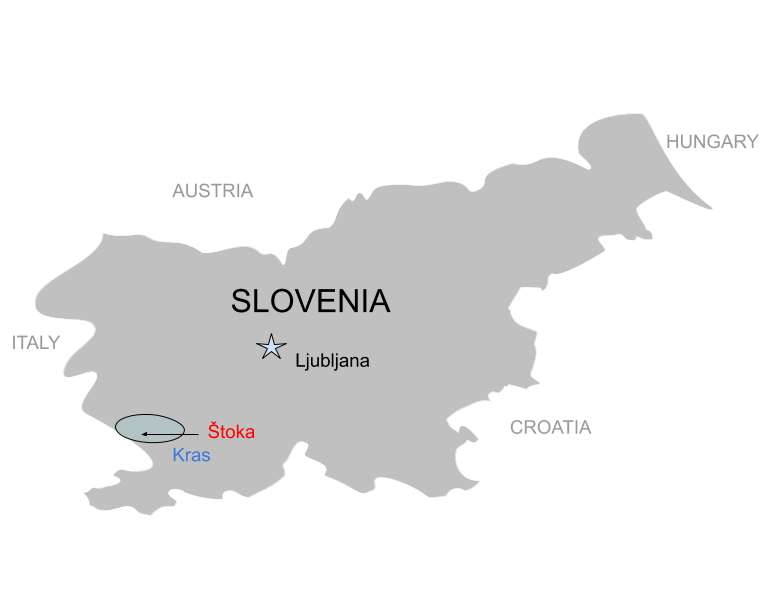2016 Štoka Izbrani Teran
Kras, Slovenia

Wind, caverns and the Adriatic Sea define the Slovenian/Italian border region of the Kras. For over 200 years the the Štoka family has nurtured the native red Teran and white Vitovska in the iron rich “terra rossa” that the Kras is famous for. Their farm is located north-east of Trieste about 5 miles from the Adriatic in the village of Krajna Vas. The Kras, or “Carso” as it is called in nearby Italy, is Europe’s first recognized cross border wine region where only 600 hectares of vines are planted between the two countries. The tiny amount of fertile soil is the result of various human and natural events. Historically oak forests dominated the land until the Venetians deforested nearly everything to build ships and city of Venice. The resulting erosion and the famously strong winds called the “burja” caused huge amounts of topsoil to simply blow away. People learned how to build stonewalls called “griže” to protect against the wind and small manmade lakes to gather rain called “kali” to keep crops alive. Farmers, including the Štoka family, even learned to transport soil to naturally protected locations. Coupled with the regions already soluble Bedrock (mostly limestone and dolomite) and lack of surface water, the Kras is riddled with sinkholes, cenotes, and massive mostly unexplored underground caves. It is one of the most severe and unique terroirs in the world.
VINEYARDS
Štoka farms about 25 hectares with roughly 7 devoted primarily to Teran with smaller parcels of Vitovska, Cabernet Sauvignon, Chardonnay, and Merlot. With soils rich in iron oxides (hematite), the drastic contrast of color between the red soil (Terra Rossa), green vines, and ripe grapes seems almost artificial. Depending on the amount of top soil, limestone rocks often stick out like teeth with surrounding vegetation struggling for survival. 250 meters above the Adriatic these sites are cooler than the more coastal Italian vineyards. The combination of wind, altitude, and proximity to the Alps are essential for accumulating greater complexity. All of the vines are about 15 years old, fertilized with cow manure, and dry farmed.
WINE MAKING
Considered one of the oldest and most revered local grapes. Harvesting is done by hand, destemmed, and macerated for 8 days before a long and slow native fermentation in large oak barrels. A small portion spends 10 months on the skins to serve as a blending agent. The wine is then racked to used barrels and moved into caves for aging. Full malolactic fermentation results in added texture and weight.
NOTES & PAIRINGS
“Izbrani Teran PTP” is a further classification of Teran PTP. “Izbrani” could be compared to the Italian “Classico” designation. Blood red in color, briny, and amaro scented with Alpine forest fruits and Mediterranean herbs, this wine is perfumed with plenty of natural acidity. Naturally high in resveratrol, lactic acid, and iron, Teran has a medicinal history dating back to Roman Times. Livia Drusilla, wife of Roman Emperor Augustus, was said to favor Teran and lived to the then impossible old age of 82. Traditionally served with cured meats, and salty rare steaks, legs of pršut (Slovenian Prosciutto) even hang in the caves used to age this wine. Decanting is recommended for at least 30 min before serving.
ANALYTICS & PRONUNCIATION
PRODUCER: Štoka (Shtoe-kah)
APPELLATION: Kras (Kraush)
VINTAGE: 2016
GRAPE COMPOSITION: 100% Teran (TehRahn)
CLIMATE: Maritime
SOILS: Red Karst (Terra Rossa)
EXPOSURE: Southwestern
MACERATION & AGING: Wild fermentation in temperature control Stainless Steel for 8 days
